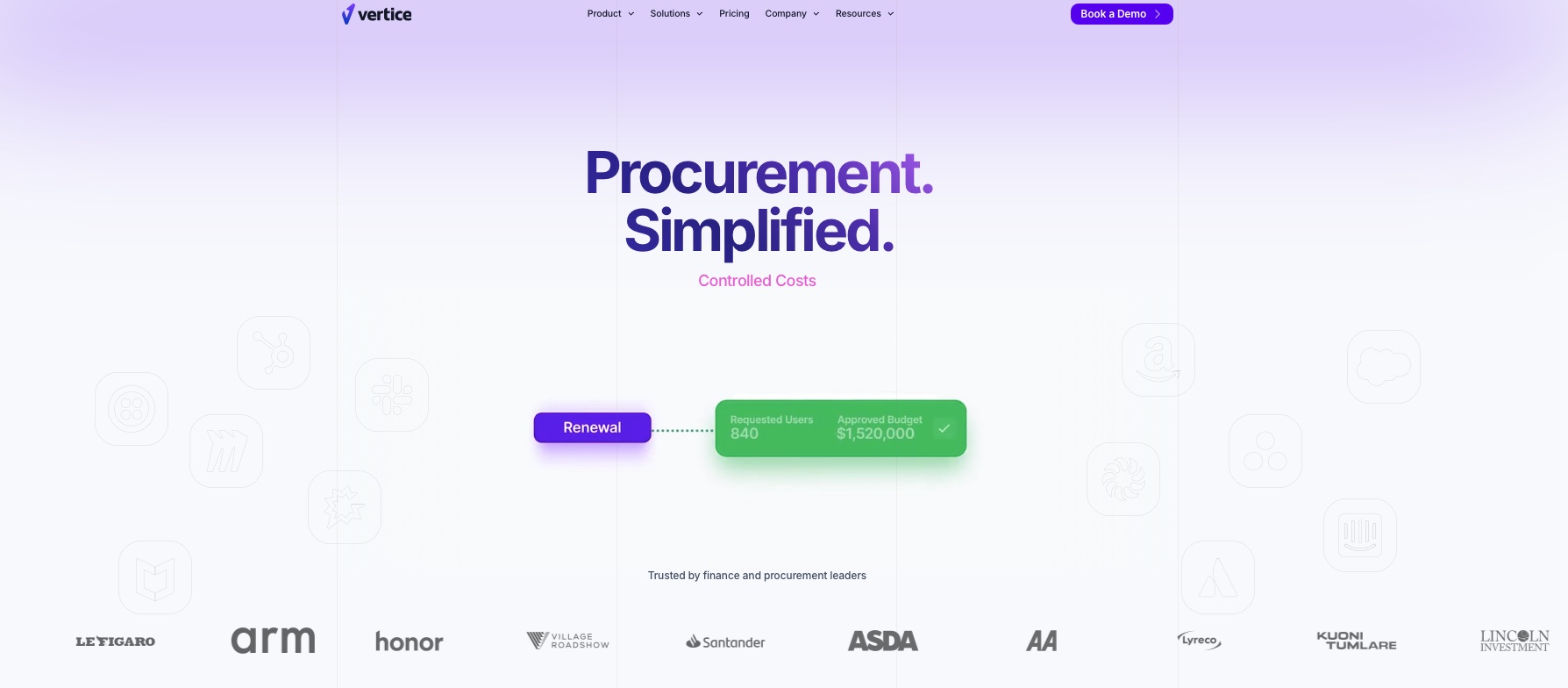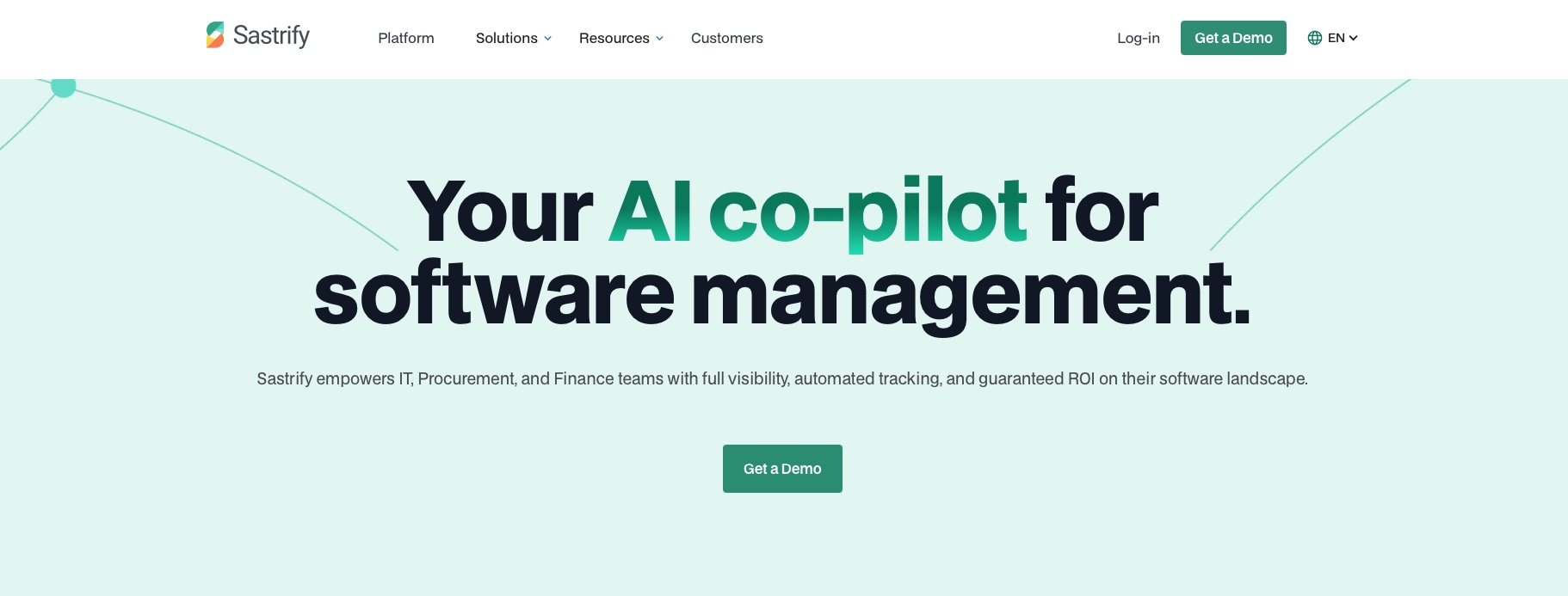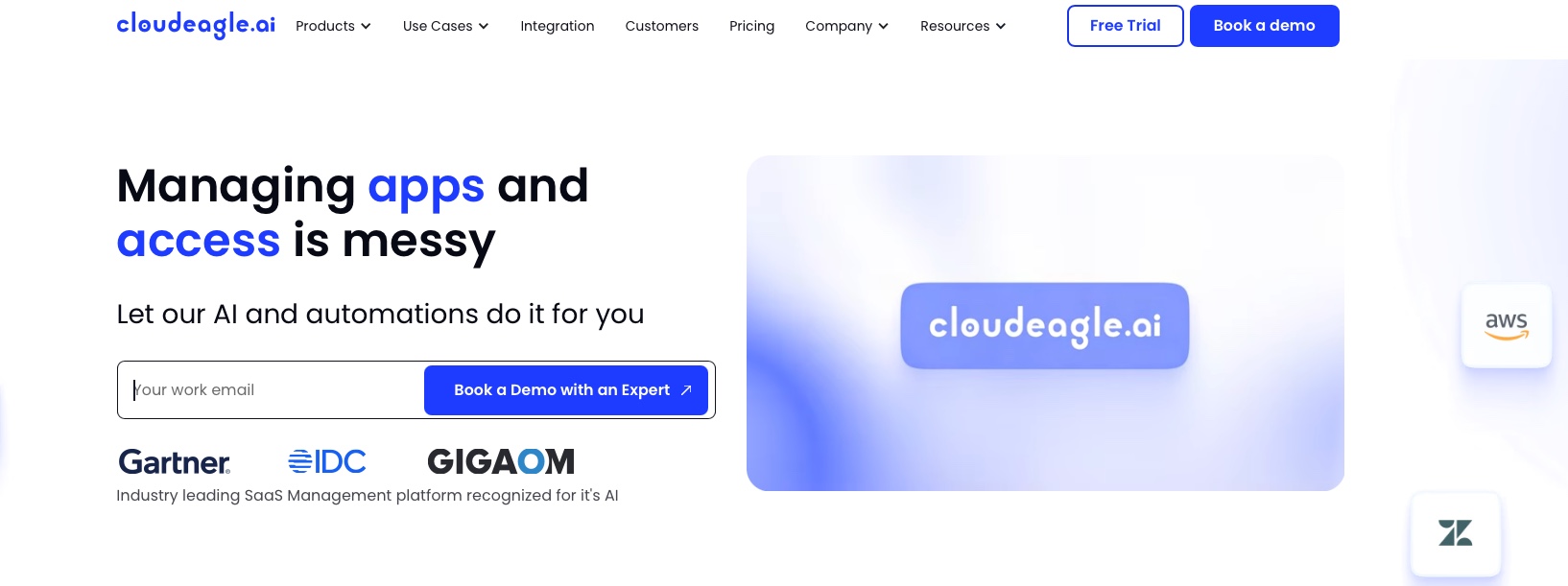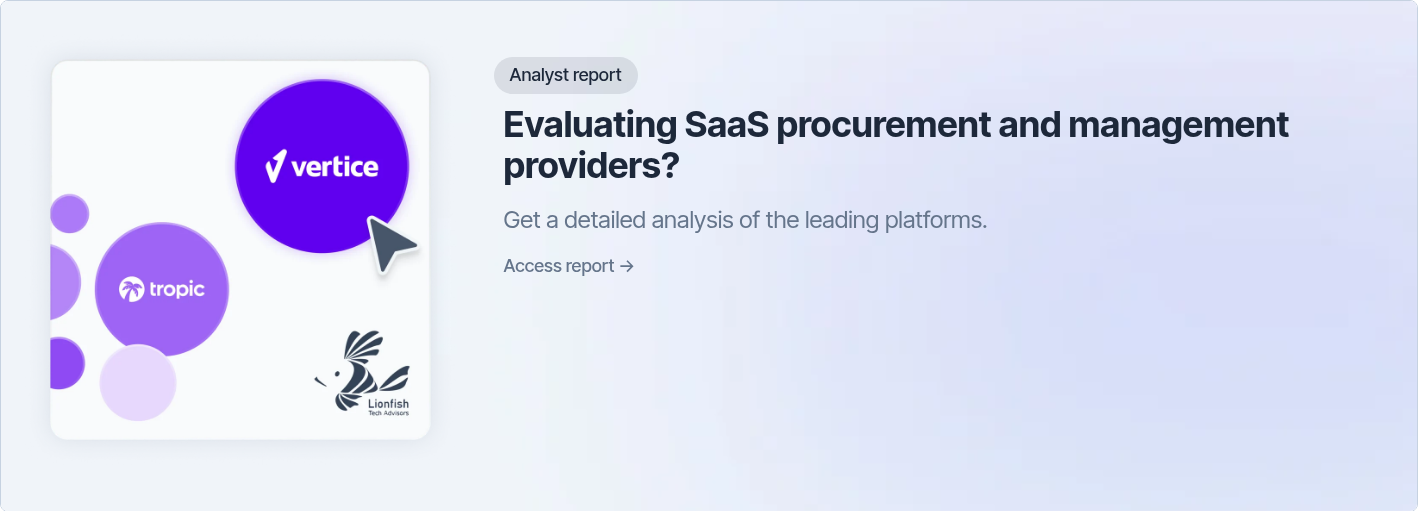The Best SaaS Management Platforms for 2026 [According to Analyst Research]
![The Best SaaS Management Platforms for 2026 [According to Analyst Research]](https://cdn.prod.website-files.com/6640cd28f51f13175e577c05/687f56f6e55f8c0078341eb6_2025-06-Lionfish-Tech-Advisors-Report-01-1080x1080.webp)
Take a self-guided tour of the platform.
See how Vertice compares.
See why Vertice is trusted by top procurement leaders.
Unlock the complete analyst evaluation of the top nine SaaS Procurement and Management Platforms.
In this guide, we’ve outlined the nine best SaaS management platforms for 2026, highlighting their key features, strengths, and the types of businesses they are best suited for.
As software grows more complex, costly, and business-critical, choosing the right SaaS management platform is essential for optimizing spend and maximizing ROI.
While reviews and demos play an integral role in evaluating these platforms, analyst reports are equally critical, outlining key evaluation criteria and objectively assessing the advantages and limitations of the leading solutions in the category.
To compile this list, we’ve drawn on recent findings from independent research firm and ex-Gartner analysts, Lionfish Tech Advisors. You can download their full report for Evaluating SaaS Procurement and Management Platforms here.
A list of the best SaaS management platforms for 2026
1. Vertice
- Employee Count: 307 as of November 2025
- Founded: 2022

Vertice provides a robust SaaS management platform that includes usage analytics, benchmarking data, and customizable, AI-enhanced intake-to-procure workflows.
Not only has Vertice been rated one of Europe's Fastest-Growing Startups in 2025 by Sifted, but users often praise the pace of innovation, speed of new product releases, the strength of negotiation services, and the quality of global benchmarking data.
What makes Vertice different?
Vertice combines AI-enhanced procurement workflows with extensive global benchmarking data, impartial negotiation support, and a guaranteed savings model.
While many of the platforms listed below also use AI agents, they are only as good as the data behind them. This is where Vertice is different – powered by advanced reasoning models and trained on over 35,000 human-negotiated contracts and 16,000+ vendors’ pricing benchmarks, the Vertice platform delivers real intelligence, not just automation.
With Vertice AI, teams gain a dedicated procurement partner that supports them at every stage of the procurement cycle. It handles everything from risk assessment to renewals, using live market data and a company’s internal context to guide each decision.
What are Vertice’s strengths?
- Vertice is a fully independent procurement partner that negotiates bespoke pricing and terms on behalf of its customers.
- Vertice places a strong emphasis on innovation and regularly invests in new product releases.
- Regional support and procurement expertise is provided across all key international markets, underpinned by an extensive global dataset for vendor benchmarking.
The types of companies Vertice is best suited for:
With dedicated buyers and global support coverage, Vertice is particularly well-suited to companies operating across multiple regions and with more than $500K in annual software spend.
2. Zylo
- Employee Count: 153 as of November 2025
- Founded: 2016

Zylo is a SaaS management platform with a strong emphasis on software discovery, license optimization, and renewal tracking. Its core strengths lie in helping companies gain visibility over their software stack, with well-regarded features for user analytics and SaaS categorization.
What are Zylo’s strengths?
- Zylo is rated well for its renewal management, user analytics, and software discovery functionality.
- The company is rated well for its support within the US.
- The company has good data coverage in the US market.
The types of companies Zylo is best suited for:
Operating exclusively in the US, Zylo may be a good fit for US-based organizations that operate domestically rather than globally. Those wanting negotiation support should be aware that while it is offered as an add-on service, it’s not a core part of Zylo’s product offering and the depth of data is somewhat limited compared to other software management providers.
3. Sastrify
- Employee Count: 66 as of November 2025
- Founded: 2022

Sastrify provides a SaaS management platform centered on compliance tracking and SaaS discovery. The company also operates its own marketplace, SastriMarket, which enables fast access to vendor discounts.
What are Sastrify’s strengths?
- Pricing for Sastrify’s entry-level plan is lower than most SPMPs.
- Sastrify is often praised for its quick onboarding and implementation process.
- The company has a strong presence in the DACH region.
The types of companies Sastrify is best suited for:
Europe-based companies focused on software visibility and compliance might find Sastrify a good choice, particularly those seeking quick access to SaaS deals, even if the savings are standardized and contract terms cannot be tailored to their specific needs.
4. Vendr
- Employee Count: 225 as of November 2025
- Founded: 2018

Vendr was one of the first players in the SaaS management space and has since evolved its model to focus on its vendor marketplace, offering companies a more streamlined way to benchmark pricing and purchase software through pre-negotiated discounts.
What are Vendr’s strengths?
- Vendr’s buyer’s guides include comprehensive SaaS pricing data and insights.
- The company has a strong knowledge of the North American market.
The types of companies Vendr is best suited for:
Companies requiring a self-serve marketplace experience and a faster way to purchase SaaS may find Vendr a good choice.
5. CloudEagle
- Employee Count: 77 as of November 2025
- Founded: 2020

CloudEagle offers a modular SaaS management platform divided into three separately priced modules: Manage, Govern, and Procure – ideal for smaller companies wanting flexibility in feature access.
The platform also boasts a wide range of direct integrations and strong data visualization capabilities, making it easy for organizations to track and manage their software spend.
What are CloudEagle’s strengths?
- CloudEagle offers an extensive selection of direct integrations within its platform.
- The company provides good support for its largely US customer base.
The types of companies CloudEagle is best suited for:
CloudEagle could be a good choice for smaller companies seeking flexibility in feature access, thanks to its modular platform. With a predominantly US focus, it is particularly well suited for organizations that operate domestically and do not require extensive global benchmarking data.
6. Najar
- Employee Count: 103 as of November 2025
- Founded: 2021

Najar provides a SaaS management platform focused on procurement, usage tracking, and spend control, and along with Vertice, is one of the few platforms on the market to include full negotiation support as part of its core offering.
What are Najar’s strengths?
- Najar has an established presence in France within the SMB and mid-market segments.
- The company subsequently has good data coverage for vendors based in France.
- Najar offers negotiation support as standard.
The types of companies Najar is best suited for:
Najar may be an ideal choice for SMBs and mid-market companies seeking an all-in-one solution, particularly those in France where Najar primarily operates. The organization's lack of international presence could make it less suitable for those operating internationally.
7. Spendbase
- Employee Count: 104 as of November 2025
- Founded: 2022

Spendbase offers a SaaS management platform with a free entry-level version, making it an accessible option for companies in their early stages looking to gain basic visibility into their software spend.
The platform provides a user-friendly interface and like several other SaaS management solutions, operates its own marketplace giving users access to immediate, pre-negotiated deals.
What are Spendbase’s strengths?
- Enables instant SaaS savings with access to standardized vendor discounts.
- Customers are generally satisfied with the level of support provided and quality of onboarding.
The types of companies Spendbase is best suited for:
Spendbase is still relatively small in comparison to some of the other leading SaaS management platforms, potentially making it a better fit for SMBs that have less complex requirements and are simply looking to gain basic visibility into their software spend.
It’s also an ideal fit for companies looking for quick SaaS discounts, rather than customized savings that take into account rather than highly customized savings that take into account detailed usage patterns, contract terms, or vendor-specific nuances.
8. Spendflo
- Employee Count: 140 as of November 2025
- Founded: 2021

Spendflo offers strong SaaS intelligence capabilities, with features such as dynamic license management and shadow IT discovery, along with its intake-to-procure functionality. It is also one of the few SaaS management providers to include negotiation services as part of its core service offering.
What are Spendflo’s strengths?
- Spendflo is rated well for its product functionality and usability.
- The company is reported to have good data coverage, particularly within the SMB space.
The types of companies Spendflo is best suited for:
Spendflo has a strong presence in the US, making it well-suited for US-based companies wanting to optimize software spend, streamline procurement, and benefit from negotiation support. However, its limited international presence may make it less suitable for larger organizations with global operations.
9. Tropic
- Employee Count: 284 as of November 2025
- Founded: 2019

Tropic offers a range of SaaS management and procurement capabilities, including price benchmarking, usage analytics, and intake-to-procure. The company regularly receives positive feedback for its product breadth and onboarding process, as well as its coverage of pricing benchmarks within the US.
What are Tropic’s strengths?
- Tropic offers a good overall scope of features and integrations.
- The company offers intake-to-procure functionality for both SaaS and non-SaaS.
- Tropic has a strong presence in the US market.
The types of companies Tropic is best suited for:
While Tropic is a solid choice for US-based companies operating domestically, the company’s primary focus on just one region may limit its ability to leverage global price points and service international organizations.
What to consider when evaluating SaaS management platforms
With so many SaaS management platforms available, taking the time to thoroughly evaluate the best one for your business is critical. Each platform varies in focus, capabilities, and level of support – and choosing the wrong one can result in missed savings, limited visibility, or unnecessary complexity.
The right solution should not only meet your current operational needs, but also scale with your organization as it grows.
Here are some key areas to assess when evaluating SaaS management providers:
- Negotiation Support – Negotiating software contracts can be both time-consuming and strategically complex. Look for platforms that offer dedicated negotiation services as a core part of their offering, rather than a paid add-on. Having experienced buyers handle this process can lead to better pricing and terms, while also reducing the burden on internal teams.
- Integration Capabilities – A platform is only as effective as the ecosystem it supports. Prioritize tools that integrate seamlessly with your existing tech stack and can accommodate new integration requests quickly. Broad and flexible integration capabilities ensure smooth data flow and more comprehensive visibility across your software environment.
- Platform Functionality & Innovation – Evaluate both the depth of current features and the provider’s pace of product development. Regular feature updates and a forward-looking roadmap signal a strong commitment to innovation. This is particularly important if your organization’s needs are evolving or if you plan to scale usage over time.
- Procurement Automation – Workflow functionality can dramatically reduce friction in software procurement and renewal processes. However, not all platforms offer the same level of sophistication. Platforms with highly customizable workflows allow organizations to match automation to their exact approval chains, policy requirements, and operational structures.
- Access to Benchmarking Data – One of the most valuable tools in SaaS management is pricing intelligence. Solutions that offer rich, up-to-date benchmarking data – including pricing, discount ranges, and peer comparisons – provide essential leverage during negotiations and renewals. This data can help you understand whether your contracts are competitive and identify opportunities for optimization.
- Savings Guarantee – While many platforms advertise cost control features, only a few back those claims with savings guarantees. If ROI is a priority, look for providers that stand behind their ability to reduce spend with a clear and measurable commitment.
See in more detail how each of the SaaS Management Platform providers rank across each of these key evaluation areas by downloading Lionfish Tech Advisor’s latest report.
Final thoughts: Choosing the best SaaS management platform
A robust SaaS management platform is no longer a nice-to-have – it’s an essential requirement for any organization wanting total software visibility, to reduce waste, and to drive better ROI on SaaS spend.
As this guide outlines, there’s no one-size-fits-all solution, with each platform coming with its own strengths. This is why it’s so critical to align your choice not only with your organization’s current needs, but also with your future requirements.
For a more detailed breakdown of how these leading platforms compare, download Lionfish’s 2025 Guide to Evaluating SaaS Procurement and Management Platforms.
Alternatively, see for yourself how Vertice can help you streamline you SaaS procurement by scheduling a demo or taking a self-guided tour of the platform at your own pace.
.webp)






.webp)